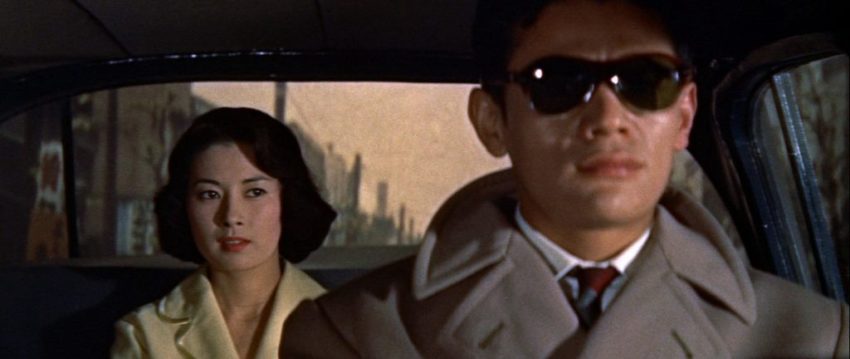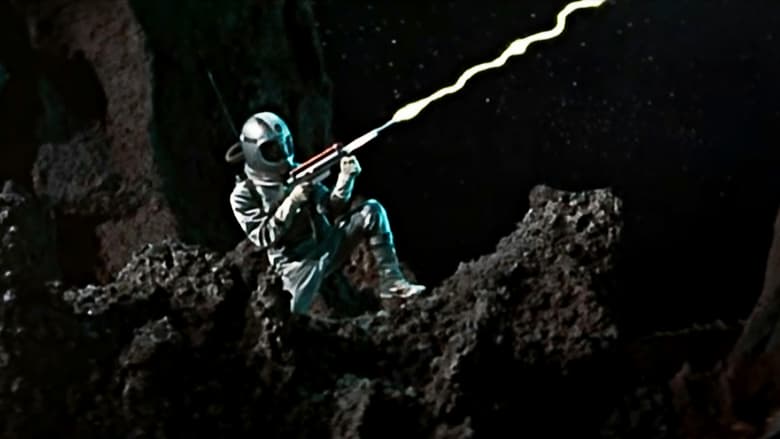Ishiro Honda Double Feature
March 31, 2021 · 0 comments
by Jeremy Clarke.

Out now on Blu-ray alongside the standalone release of Mothra (1961) comes a double bill of two more Toho science fiction movies, The H Man (1958) and Battle in Outer Space (1959), both also directed by Ishiro Honda with special effects by Eiji Tsuburaya. The Toho studio is more readily associated with monster movies than any other type of film in the popular mind, notably Godzilla (1954), Mothra and a slew of similar films. The superior entries in this cycle tend to be the ones with the Honda and Tsuburaya dream team, including the initial 1954 film which ticked all the right boxes and proved a massive success.
When no-one at Toho was quite sure what had made Godzilla work, Honda and Tsuburaya collaborated on a number of different SF films before everything came together on Mothra. The H Man is a monster film dressed up in gangster trappings while Battle in Outer Space is an epic with space stations, flying saucers, rocket ships, an alien moon base and alien mind control. As with Eureka!’s Mothra disc, this release contains not only Toho’s Japanese version of each film but also Columbia’s slightly different version dubbed for the US market. The US version of The H Man is about six minutes shorter. Each version has a commentary, one by David Kalat, author of A Critical History and Filmography of Toho’s Godzilla Series, the other by Steve Ryfle and Ed Godziszewski, authors of Ishiro Honda: A Life in Film, From Godzilla to Kurosawa.

The H Man (lit. Beauty and the Liquid People) was scripted by Takashi Kimura, who, as Jasper Sharp notes in the accompanying booklet, wrote monster movies for Honda where the monsters were liquid, gas (The Human Vapor, 1960) and mutant man-mushrooms (Matango, 1963). All these can be read as the elements constituting the clouds – or mushroom clouds – of nuclear bombs dropped on Japan or tested near it.
Yet after opening with nuclear explosion stock footage, the film swiftly morphs into a police procedural in which various characters mysteriously disappear – they’re standing there one minute and their bodies are literally collapsing before our eyes the next. What could be causing this effect? Sticking to cops-and-robbers genre expectations, Inspector Tominaga (Akihito Hiraka) refuses to entertain any notion more suited to horror or science fiction and assumes this all might be down to revenge or turf war or something similar. However, on this basis, the police can’t get any theories to add up.
The detective is also is bombarded with ideas by obsessed scientist Dr Masada (Kenji Sahara), who does his best to protect witness and nightclub singer Chikako (Yumi Shirakawa). Like the songstress in Warning from Space (1956), she gets a scene performing a song, putting the drama on hold for a few minutes while the audience enjoy the musical entertainment, something unthinkable in American sci-fi.

Elsewhere, sailors board a seemingly deserted vessel where the captain’s log has mysteriously been abandoned, the crew have mutated into ghostlike beings and a bizarre liquid life-form consumes any human it touches. This gives Tsuburaya the chance to create such memorable visuals as pools of goop that creep under doors and live human beings who suddenly and terrifyingly implode and deflate. The gripping finale involves a gangster taking Chikako hostage and dragging her into the sewer, where the authorities coincidentally plan to trap the monster and destroy it using a deadly mixture of petrol and fire.
Since the strange beings are never really defined, perhaps they don’t resonate with the Japanese national psyche in the way that Godzilla continues to. Nevertheless, it’s a fascinating little movie, partly because of the way it traverses disparate genres which don’t normally come anywhere near each other, and partly because of the unusual way in which it attempts to confront the Japanese nuclear trauma.
Battle in Outer Space (lit. The Great Space War) is one of those films that paints on a bigger canvas and sacrifices character development in favour of big-screen visual spectacle, brought to life with state-of-the-art special effects. According to Kalat, the film owes much to the bigger Hollywood 1950s SF feature film films made in colour. These include not only films by former Puppetoon animation creator George Pal such as The War of the Worlds (1953) and Conquest Of Space (1955) but also This Island Earth (1955) and Forbidden Planet (1956).

Honda’s film wades straight in to alien war scenarios, with UFOs destroying a space station in Earth’s orbit and using a freezing ray to cause objects to float upwards into the sky. This makes no more sense when a scientist stands up at a conference and explains the theory in some detail. Kalat’s commentary talks about the 1950s as the decade where an information-hungry public was unfamiliar with the basic science of space travel, so a concept like zero gravity and weightlessness could give rise to the bizarre gag where an astronaut suddenly floats up to the roof of a spaceship interior to the amusement of his colleagues. Near identical gags can apparently be found in George Pal’s productions Destination Moon (1950) and Conquest of Space.
Screenwriter Shinichi Sekizawa doesn’t display the slightest interest in why the aliens might be attacking Earth. Instead, he just gets on with it, dispensing with logic so that after the opening mayhem, the aliens disrupt a rocket test not by sending in the big guns to destroy it but by controlling the mind of Iranian scientist Dr Ahmed (George Whitman) and arming him with a hand gun at a conference. This sequence bucks the common US movie trend of having only delegates from the home country say anything of significance – the discussion involves speakers from not only Japan but also India, East Germany and the Philippines. When they get round to deciding who will send an expedition to the moon, there are two ships – one manned by Japanese under Katsumiya (Ryu Ikebe), one by Americans. The subsequent action ignores the US contingent, though the part played by both groups appears equally significant. Equally noteworthy is the inclusion of a woman, Etsuko Shiraishi (Kyoko Anzai), among the astronauts, even if the script relegates her to damsel in distress a little too readily. Also on board is the alien mind-controlled Iwomura (Yoshio Tsuchiya, who seems to relish exploring his character’s demented plight on screen). After wresting control of his mind back from the aliens, he becomes a lone figure in the mountains of the moon fighting their ships with a ray gun.

Tsuburaya’s contributions include flying saucers and rocket ships galore, ray weapons and space torpedoes which are essentially guided meteors. He wreaks destructive mayhem upon New York, San Francisco’s Golden Gate Bridge and, inevitably, a sizeable section of Tokyo which includes a cinema building advertising Cinerama. Perhaps best of all is the lunar landscape crossed by manned rover craft. When the live-action astronauts are in the rover as it travels across the terrain, the model landscape can be viewed through the windows by virtue of the blue-screen backing process anticipating similar moon-traversing shots in 2001 (1968).
Two relevant extracts from Ryfle and Godziszewski’s book appears in the disc’s highly informative 40-page booklet which also features writing by Christopher Stewardson and Jasper Sharp.
Ishiro Honda Double Feature: The H Man / Battle in Outer Space is released on Eureka! Blu-ray in the UK and Ireland.
Jeremy Clarke’s new website is jeremycprocessing.com
Leave a Reply